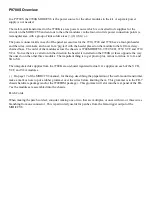
Operation Manual
MELA
quick
®
12
Page 14
separate steam generation excludes an overheat of instruments and of the chamber, too.
5.3
Use of aqua dest / aqua dem_______________________________________________
Quality requirements
It is important to use distilled water (aqua dest) or
demineralized water (aqua dem) for steam
sterilization.
As directions for water quality, refer to the values in
the nearby table according to CEN-standard DIN EN
285.
For the operation of the MELAquick
®
12
and for all
other MELAG autoclaves, however,
battery water
in accordance with VDE 510
is also adequate. The
stipulations of VDE must be strictly observed here,
however: conductivity upon processing of the water
≤
10
µ
S/cm*
)
, and upon use
≤
30
µ
S/cm*
)
, pH
identical to stipulations of DIN EN 285, and residue
of evaporation comparable.
Automatic testing of conductivity
Immediately after start of he program, the autoclave
tests the water conductivity in the water storage tank
(see Section 1.7).
If the water quality is adequate, the program will run
normally. If the water conductivity is between
approx. 25 and 40
µ
S/cm*
)
, the
lamp
„
WATER“ (9)
will
flash to warn the operator. The program will,
however, continue to run normally. If the water
conductivity is greater than approx. 40
µ
S/cm*
)
, the
lamp
„
WATER“ (9) will flash,
a fault message will
be triggered, and the
lamp
„
FAULT“ (10) will glow.
In such case, in order to protect the instruments and
the autoclave, the program will not start. The
operator must replace the water in the tank by better
(for example demineralized) water and press the
„
START“ button (7) again.
Suppliers of adequate water
Battery water in accordance with VDE 510 is
economically supplied by all major drug stores,
supermarkets, home-construction marts, as well as
from wholesalers. In Germany, however, the seal for
VDE 510 must be expressly displayed on the label.
Functional effectiveness
If you do not pay attention to the directions above,
deposits of lime in steam pipes, valves and flow
nozzle can impair the autoclave's functional
effectiveness. Aggressive water (pH <5 or >7) can
also damage the apparatus.
It is only for high values of
conductivity
that the
autoclave triggers a warning or fault alarm. See
Section 1.7.
Steam formation
The extent of stain formation on instruments de-
pends on the quality of water used for steam gen-
eration.
vapour residues
≤
10 mg/l
silica, SiO2
≤
1 mg/l
iron
≤
0,2 mg/l
cadmium
≤
0,005 mg/l
lead
≤
0,05 mg/l
heavy metals expect the
ones above
≤
0,1 mg/l
chlorides
≤
2 mg/l
phosphates
≤
0,5 mg/l
conductivity
≤
15
µ
S/cm
*
)
pH - value
5 to 7
colour colourless,
clear
without residues
hardness
≤
0,02 mmol/l
Note:
Use of the water with elements above the values in
the table can shorten life of the autoclave very much
and can probably eliminate the manufacturer's
warranty.
*
)
µ
S/cm = Micro Siemens per centimetre
5.3.1 Amount of consumption _________________________________________________________
Water in the reservoir decreases each process with
the amount needed for one sterilization/disinfection
(one-way system).
The MELAquick
®
12
requires approx. 150 ml of
distilled or demineralized water per sterilization or
disinfection cycle.
When the water storage tank is full, it is possible to
conduct approx. 28 sterilization cycles until the lamp
„
WATER“ (9) glows. Then the operator must refill the
water tank.
5.3.2 Emptying the water storage tank __________________________________________________
If the autoclave must be transported, or if it will
remain out of operation for a lengthy period of time
(over about 14 days, depending on the water quality
and temperature), then it is necessary to empty the
water storage tank to prevent soiling due to growth
of algae, etc.
For emptying the water storage tank, it is necessary
to turn the autoclave so that the rear part protrudes
about 12...15 cm over the edge of the table. You can
now see a rubber bung (19) under the autoclave.
Pull out the bung and the hose to which the bung is
connected until you can feel a definite resistance.
Then put a container underneath, pull the bung out
of the hose and wait until the reservoir is completely
empty. Stick the bung back into the hose and the
hose back into the autoclave.











































